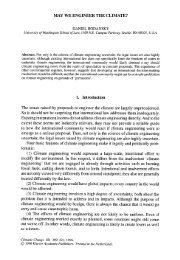ThorEA - Towards an Alternative Nuclear Future.pdf
ThorEA - Towards an Alternative Nuclear Future.pdf
ThorEA - Towards an Alternative Nuclear Future.pdf
Create successful ePaper yourself
Turn your PDF publications into a flip-book with our unique Google optimized e-Paper software.
Q4. Early investment in accelerator technology at this tipping point in ADSR development has a good probability of a high<br />
long-term return. Few technological adv<strong>an</strong>ces would be as globally tr<strong>an</strong>sformative as robust ADSR power generation,<br />
<strong>an</strong>d tr<strong>an</strong>smutation. ADSR accelerator R&D would also pay other dividends – foreseeable <strong>an</strong>d unforeseeable – even if<br />
robust ADSR power generation c<strong>an</strong> not be achieved. Now is the right time for the UK to make a well-considered entry<br />
into ADSR accelerator R&D. The <strong>ThorEA</strong> proposal is a good starting point from which to discuss a reasonable portfolio<br />
of risk for the UK Accelerator R&D programme, but should the UK could choose to compete or collaborate with other<br />
countries, inside or outside the EU?<br />
A4. The competition vs collaboration argument is <strong>an</strong> interesting one: In principle there are perhaps two strategic choices:<br />
1. A Europe<strong>an</strong> project with EU political constraints <strong>an</strong>d pace<br />
2. A UK National project helping to rebuild national capacity with public money (as part of a UK return to industrial policy)<br />
The prize for successfully competing with other countries in ADSR technology is subst<strong>an</strong>tial. At present estimates ~£30<br />
billion plus will be spent on nuclear power in UK over next ten years. This will have macro-level effects on UK economy.<br />
Developing <strong>an</strong> ADSR capability for UK industry will have comparable effects.<br />
Conversely there are aspects of ADSR R&D for which collaboration could be desirable, possible <strong>an</strong>d fruitful. However, until<br />
the <strong>ThorEA</strong> initiative, the UK had little to take to the international ADSR table. The <strong>ThorEA</strong> project could place the UK at the<br />
very centre of global ADSR collaborations.<br />
Q5. <strong>ThorEA</strong> suggests that a 10 MW accelerator will require approximately 20 MWe to sustain its operation.” Is this realistic?<br />
A5. The estimate of 20 MW wall-plug power comes from the typical accelerating structure efficiency, which is where most of the<br />
power will go. A more robust estimate is needed, <strong>an</strong>d will indeed be determined as part of the R&D programme. However,<br />
this is not a critical issue for the development of ADSR technology. Even a doubling of the estimated power dem<strong>an</strong>d to<br />
40MW will not ch<strong>an</strong>ge the overall feasibility of the proposed ADSR scheme.<br />
Q6. The <strong>ThorEA</strong> report states that “… <strong>an</strong> extensive <strong>an</strong>d coherent research <strong>an</strong>d development (R&D) programme could secure<br />
all underpinning technology necessary to facilitate construction of the world’s first thorium-fuelled ADSR power<br />
station in the UK by the target date of 2025.” Is this date realistic?<br />
A6. The time scale for this, as for <strong>an</strong>y highly technical project, is clearly dependent upon both technological development<br />
<strong>an</strong>d political will. The suggested five year development programme for the basic ADSR technology is fully consistent with<br />
the development <strong>an</strong>d delivery of, for example, scaling FFAG technology in Jap<strong>an</strong>; the development of SNS <strong>an</strong>d J-PARC; the<br />
construction 25 years ago of the world leading ISIS facility; our own ns-FFAG CONFORM project; <strong>an</strong>d the projected schedule<br />
for delivering the 5MW accelerator stage of ESS. It is also commensurate with the suggested time scale of the MYRRHA<br />
project, which does not have the critical adv<strong>an</strong>tage of the global lead in innovative (ns-FFAG) technology provided by our<br />
CONFORM project. Additionally, it should be noted that the time scale 2025/2030 is not overly critical to the proposed R&D<br />
programme. The intention is to demonstrate thorium fuelled ADSR technology as a timely alternative to plutonium fuelled<br />
GEN IV systems, which are scheduled to come on line in 2030.<br />
Q7. <strong>ThorEA</strong> suggest “The principal objective of the five year AESIR (Accelerator Energy Systems with Inbuilt Reliability)<br />
R&D programme is to design, build <strong>an</strong>d demonstrate a robust <strong>an</strong>d reliable prototype accelerator system which will<br />
be suitable for mass production <strong>an</strong>d commercialisation as <strong>an</strong> ADSR proton driver.” C<strong>an</strong> this be done in 5 years: the<br />
current state-of-the-art is the 5 MW ESS, which will take 10 years to design, build, <strong>an</strong>d commission?<br />
A7. Unfortunately this is a mistaken comparison with ESS: the ESS driver itself will not take 10 years to design build <strong>an</strong>d<br />
commission. The ESS, as fully working 5MW spallation source delivering neutrons, will take as little as nine years to<br />
complete. This suggests that coupling the development of the accelerator/target assembly design with the parallel design<br />
<strong>an</strong>d development of <strong>an</strong> ADSR core will indeed be possible on a 15 year timescale. Again, we emphasise that the tome scale<br />
of the <strong>ThorEA</strong> project is entirely comparable with estimates for the MYRRHA project.<br />
A report prepared by: the thorium energy amplifier association 67



